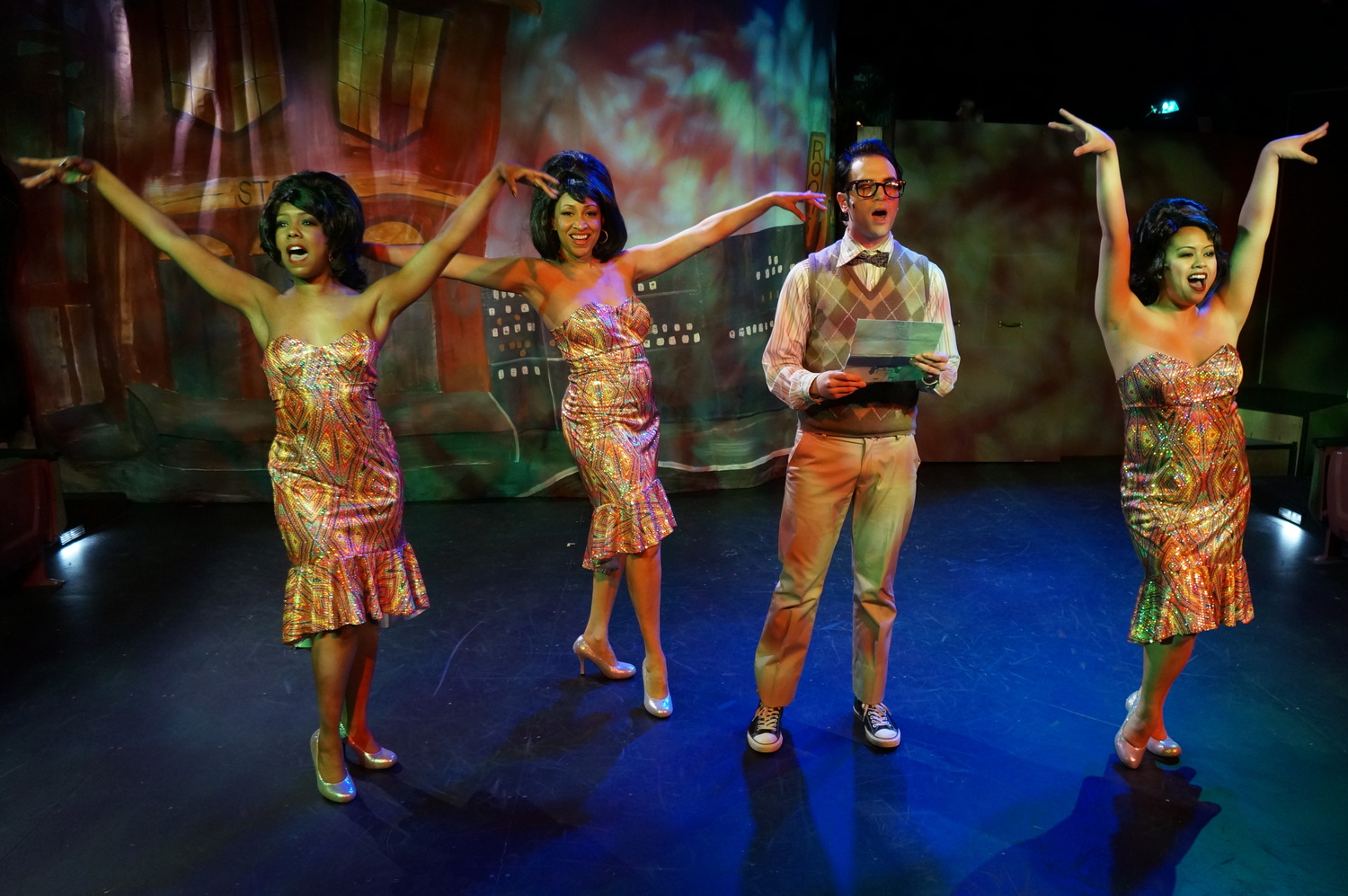Review of Little Shop of Horrors at Music Theatre of Connecticut (MTC)
Little Shop of Horrors, a campy rock musical with a cozy cast of eight—plus a talking plant—is understandably enticing to any Artistic Director of an intimate theatre. But beware! If the director isn’t careful, this fanciful show can—like the exotic Venus fly trap, Audrey II, who consumes the lives of the characters—overpower the space and dominate even the most skilled and charming actors.
Such is the case with the current production of Little Shop of Horrors at the Music Theatre of Connecticut (MTC). In a 200-seat house, the audience is snuggled right up to the outsized and often demented action, which is all part of the fun. But where director Kevin Connors, musical director Thomas Martin Conroy, and vocal arranger Robert Billig make a serious mistake is in their collaborative sound design. Each of the very strong singers is electronically amplified, and each has been encouraged to sing full out. Not only does this make for a show that is simply too loud, but the clever lyrics (written by Howard Ashman, who also wrote the book) are often garbled, through no fault of the singers themselves.
We need those lyrics, not only for their wit, but also because, as with any fine musical, the songs advance the plot, elucidate the relationships, and raise the stakes of the story. For those not familiar with Little Shop, picture the legend of Dr. Faustus set to the sounds of doo-wop, early Motown, and 1960’s rock and roll. In Skid Row, a sweet schlemiel, Seymour (Anthony DiCostanzo), works at a failing flower shop under Mr. Mushnik (Lou Ursone), his irate boss. The only light in his life is his fellow florist, the lovely Audrey (Elissa DeMaria). Audrey regularly comes in with a black eye or broken arm, courtesy of her sadistic boyfriend, Orin (Tony Lawson), a dentist.
Just before the shop is about to go under, Seymour produces a strange plant that he’s been tending, and this plant begins to draw customers’ attention. Voiced by Peter McClung, Audrey II, as Seymour wistfully names his botanical discovery, also begins to draw blood—first Seymour’s, and then . . . well, you know, it’s your basic Faustian pact. Will Seymour give into Audrey II’s burgeoning appetite in exchange for fame, money, and the ability to provide his beloved the perfect house and garden she longs for? Or will he resist, and risk living on Skid Row forever?
Helping to fill in this bizarre and comic plot are a Greek chorus of three Supremes-like singers—Chiffon (Inuka Ivaska), Crystal (Kristian Espiritu), and Ronette (Gabrielle Lee)—and a three-piece band playing Alan Menken’s marvelous score: Thomas Martin Conroy on keyboards; Dan Asher/Henry Lugo on bass; and Chris Johnson on drums.
The problems with sound are especially unfortunate because nearly every actor has been cast well and performs expertly. DiCostanzo and DeMaria are especially winning, both in their separate roles and as a lovestruck, star-crossed couple. DiCostanzo looks wonderfully nerdy yet sings like an angel, which is just right for the role. DeMaria has the difficult task of performing broadly but never losing our sympathy, and she makes playing Audrey look easy. As Mr. Mushnik, Lou Ursone, a fine singer and dancer, has wonderfully comic moments, especially in his appeal to adopt the suddenly famous Seymour (“Mushnik and Son”). Ivaska, Espiritu, and Lee, though especially hampered by the decision to amplify their already big voices, execute their moves with the requisite fire and sass.
In the only questionable casting, Tony Lawson stretches credulity as Orsin. Lawson’s performance itself is suitably funny and frightening. A combination of early Elvis and James Dean, he hits his girl and loves to cause his dental patients anguish (“Dentist!”). But where Lawson has a physical softness about him, Orsin needs to come across as sharp and strikingly seductive.
While the costumes, designed by Diane Vanderkroef, are just right in nearly every case, director Connors should have caught the problem, late in the show, where Chiffon, Crystal, and Ronette all appear in the same glittering dress. Each of the three women is shaped very differently, and one style does not fit all. Vanderkroef could have achieved the same effect with identical fabric, cut to flatter.
In designing the set, David Heuvelman faces a challenge: important action occurs inside the flower shop, while the actors need as much external playing space as possible. Heuvelman accomplishes this, but his set is far from visually arresting. In particular, if a curtain is going to be pulled across the shop to represent the degraded world of Skid Row, it must be expertly painted. Unfortunately, it’s not. Skid Row is a character in itself, inspiring not one but two songs (“Skid Row (Downtown)” and “Somewhere It’s Green”), and as such, should be a place darkly, stylishly realized.
A musical that’s hard to listen to and lacks an evocative design can hardly be considered a success. However, MTC’s Little Shop of Horrors must be commended for its actors, who bring style, sweetness, and commitment to this wacky, twisted tale.
Little Shop of Horrors
Book and Lyrics by Howard Ashman; Music by Alan Menken
Based on the film by Roger Corman; Screenplay by Charles Griffith
Directed by Kevin Connors
Musical Direction by Thomas Martin Conroy
Vocal Arrangements: Robert Billig; Orchestrations: Robert Merkin; Choreography: Steven Midura; Set Design: David Heuvelman; Audrey II Design: Erin Flanagan Lind & Corey T. Lind; Audrey II Puppeteer: Will Strong; Costume Design: Diane Vanderkroef; Lighting Design: Tyler H. First; Stage Manager: Jim Schilling
Music Theatre of Connecticut (MTC)
509 Westport Avenue, Norwalk
April 17-May 3, 2015




